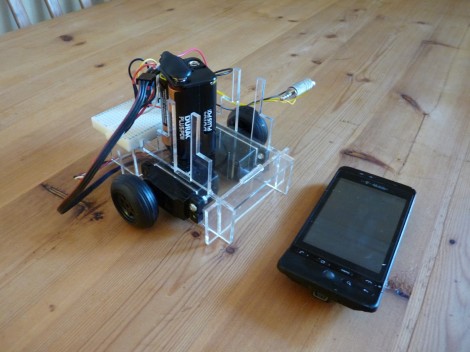
[Jim] has an old Android phone he’d like to use as a Robot brain. It’s got a lot of the things you’d want in a robot platform; WiFi, Bluetooth, a camera, an accelerometer, etc. But he needed some way to make the mobile, mobile. What he came up with is a chassis with servos that can be controlled by the phone’s audio port.
To start his adventure he crafted a square wave audio file in Audacity and then played it back on the Android music player. By monitoring the output on an oscilloscope he found the wave was well produced, with peaks of about 1V. With that in mind he designed a circuit using two transistors to amplify the signal, thereby creating a usable input for the servo motors. Each motor has one of these circuits connected to it, with the left and right channels from the audio jack driving them separately. In the clip after the break you can see he even wrote a simple Android app to extend the idea to a more usable level.
This is a similar technique as used by the recon robot we saw about a year ago.















If you have an inexpensive PPM R/C receiver, you could feed it the audio signal and control N-channels that way…
Another example of sound is an executable file, it won’t work if you muck it up. The file must be audio (wave) not mp3 (mpee).
Isn’t this the basis of a Romotive bot?
http://romotive.com/
Jim, nicely done! The positioning looks pretty accurate and the video demo is cool too. :)
So it’s like a dog whistle for your robots?
Next, hack this into a Big Trak.
http://en.wikipedia.org/wiki/Big_Trak
Bleedin’ obvious its design was inspired by the original Battlestar Galactica TV series, especially in its silver colored plastic version sold in the USA.
I have one of those cheap “3 channel” IR controlled helicopters that uses the headphone jack to drive a small emitter module that turns the iPhone into the RC controller
In the video clip (2:20) : “The video is a little bit laggy and a little bit upside down”
Love it!
Nice work! We built a similar project. However, we installed an Android device onto a RC car and used an IOIO board instead to control it autonomously. Here is the preliminary result:
http://youtu.be/vkvkfcqEUkk
I like this project
Can you post the circuit diagram of the transistors please
I will make one